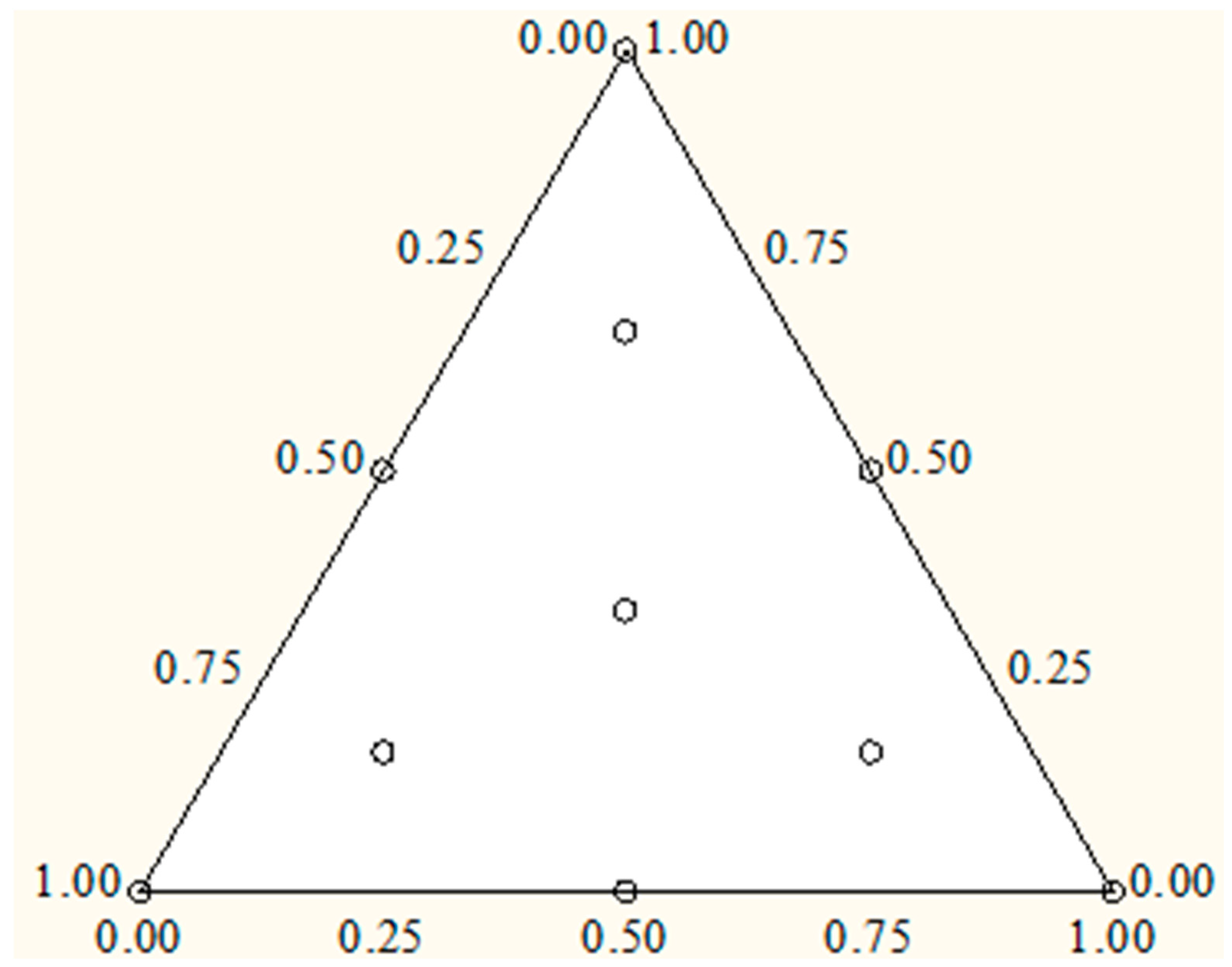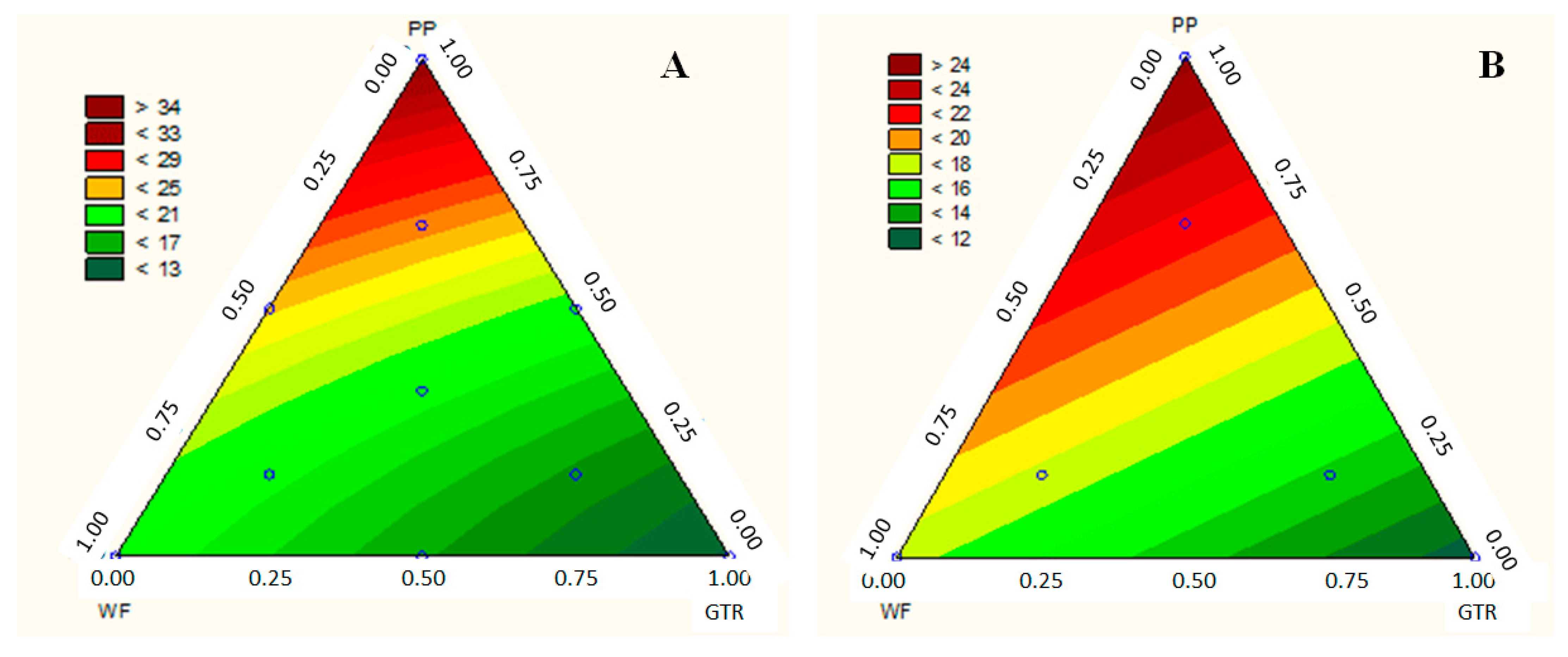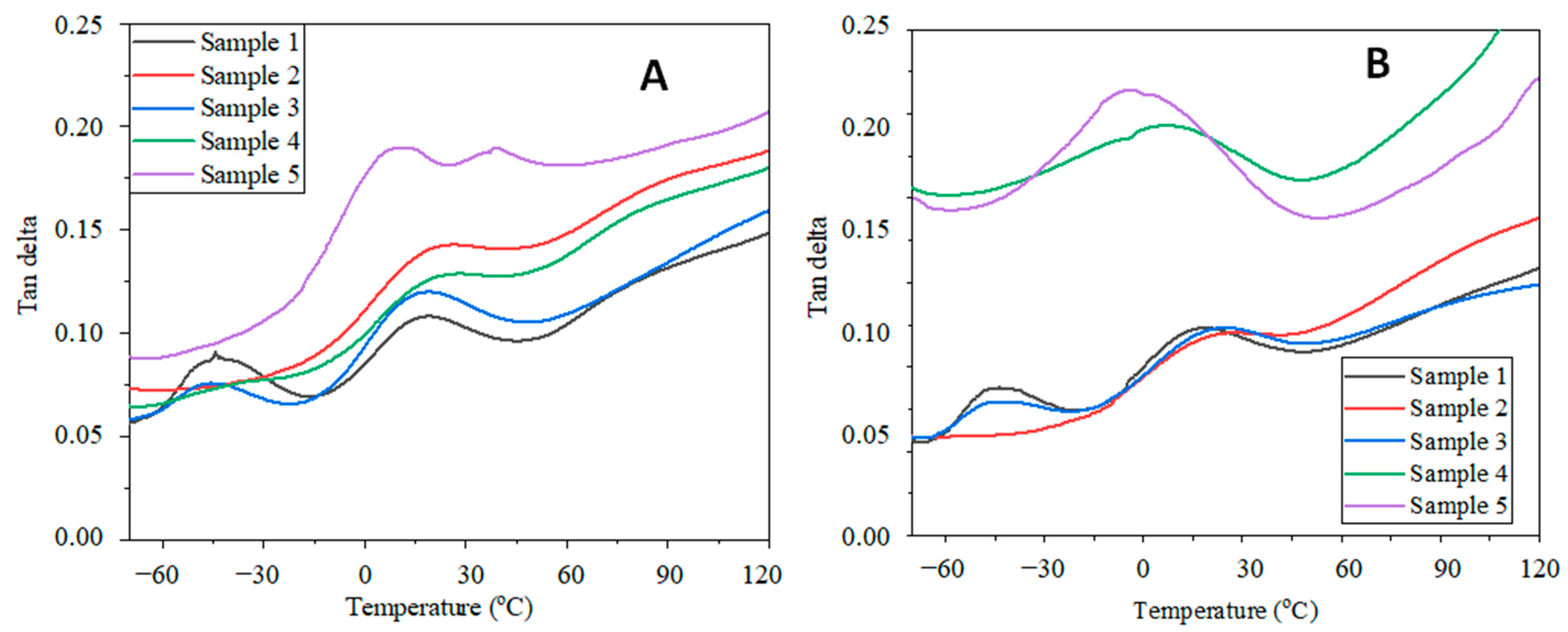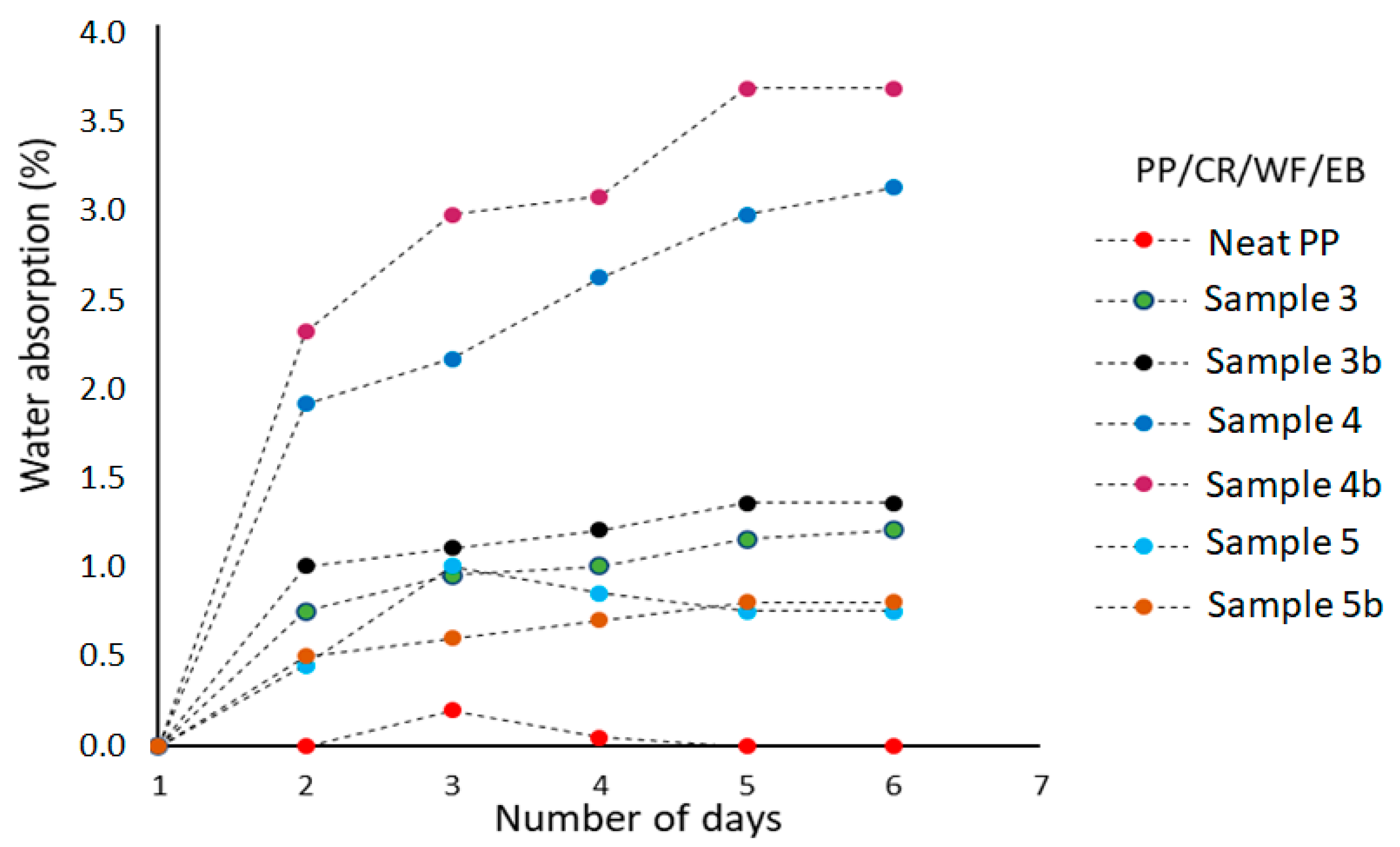Effect of Ethylene-1-Butene as a Compatibilizer for the Optimization of Wood Flour and Ground Tyre Rubber in Polypropylene Composites
Abstract
:1. Introduction
2. Materials and Methods
2.1. Materials and Chemicals
2.2. Mixing Approach and Injection Molding Procedures
2.3. Thermal Analysis of the Composites
2.4. Water-Resistance Analysis of the Composites
2.5. Mechanical Analysis of the Composites
2.6. Dynamic Mechanical Analysis of the Composites
2.7. Morphological Analysis of the Composites
3. Results and Discussion
3.1. Thermal Properties of the PP/GTR/WF Composites
3.2. Mechanical Properties of the PP/GTR/WF Composites
3.3. Dynamic Mechanical Properties of the PP/GTR/WF Composites
3.4. Water Resistance Properties of the PP/GTR/WF Composites
3.5. Morphological Properties of the PP/GTR/WF Composites
4. Conclusions
Author Contributions
Funding
Institutional Review Board Statement
Informed Consent Statement
Data Availability Statement
Acknowledgments
Conflicts of Interest
References
- Toommee, S.; Pratumpong, P. PEG-Template for Surface Modification of Zeolite: A Convenient Material to the Design of Polypropylene Based Composite for Packaging Films. Results Phys. 2018, 9, 71–77. [Google Scholar] [CrossRef]
- Simon, D.Á.; Halász, I.Z.; Karger-Kocsis, J.; Bárány, T. Microwave Devulcanized Crumb Rubbers in Polypropylene Based Thermoplastic Dynamic Vulcanizates. Polymers 2018, 10, 767. [Google Scholar] [CrossRef] [PubMed] [Green Version]
- Ndiaye, D.; Diop, B.; Thiandoume, C.; Fall, P.A.; Farota, K.A.; Tidjani, A. Morphology and Thermo Mechanical Properties of Wood/Polypropylene Composites. In Polypropylene; Intech Open Acess: London, UK, 2012; pp. 415–425. ISBN 978-953-51-0636-4. [Google Scholar]
- Luo, J.; Li, Q.; Shang, H.; Gao, S.; Zhang, C.; Sun, S. Mechanical and Damping Properties of Wood Plastic Composite Modified by Ground Waste Rubber Tire. Prog. Rubber. Plast. Recycl. Technol. 2017, 33, 127–138. [Google Scholar] [CrossRef]
- Song, Y.; Wang, Q.; Han, G.; Wang, H.; Gao, H. Effects of Two Modification Methods on the Mechanical Properties of Wood Flour/Recycled Plastic Blends Composites: Addition of Thermoplastic Elastomer SEBS-g-MAH and in-Situ Grafting MAH. J. For. Res. 2010, 21, 373–378. [Google Scholar] [CrossRef]
- Soccalingame, L.; Perrin, D.; Bénézet, J.-C.; Bergeret, A. Reprocessing of UV-Weathered Wood Flour Reinforced Polypropylene Composites: Study of a Natural Outdoor Exposure. Polym. Degrad. Stab. 2016, 133, 389–398. [Google Scholar] [CrossRef]
- Caveda, S.; Pérez, E.; Blázquez-Blázquez, E.; Peña, B.; van Grieken, R.; Suárez, I.; Benavente, R. Influence of Structure on the Properties of Polypropylene Copolymers and Terpolymers. Polym. Test. 2017, 62, 23–32. [Google Scholar] [CrossRef] [Green Version]
- Maddah, H.A. Polypropylene as a Promising Plastic: A Review. Am. J. Polym. Sci. 2016, 6, 1–11. [Google Scholar] [CrossRef]
- Girones, J.; Vo, L.T.T.; Haudin, J.-M.; Freire, L.; Navard, P. Crystallization of Polypropylene in the Presence of Biomass-Based Fillers of Different Compositions. Polymer (Guildf). 2017, 127, 220–231. [Google Scholar] [CrossRef]
- Kazemi Najafi, S. Use of Recycled Plastics in Wood Plastic Composites—A Review. Waste Manag. 2013, 33, 1898–1905. [Google Scholar] [CrossRef]
- Zhao, J.; Wang, X.-M.; Chang, J.M.; Yao, Y.; Cui, Q. Sound Insulation Property of Wood–Waste Tire Rubber Composite. Compos. Sci. Technol. 2010, 70, 2033–2038. [Google Scholar] [CrossRef]
- Chan, C.M.; Vandi, L.-J.; Pratt, S.; Halley, P.; Richardson, D.; Werker, A.; Laycock, B. Composites of Wood and Biodegradable Thermoplastics: A Review. Polym. Rev. 2018, 58, 444–494. [Google Scholar] [CrossRef]
- Ramarad, S.; Khalid, M.; Ratnam, C.T.; Chuah, A.L.; Rashmi, W. Waste Tire Rubber in Polymer Blends: A Review on the Evolution, Properties and Future. Prog. Mater. Sci. 2015, 72, 100–140. [Google Scholar] [CrossRef]
- Peng, Y.; Liu, R.; Cao, J. Characterization of Surface Chemistry and Crystallization Behavior of Polypropylene Composites Reinforced with Wood Flour, Cellulose, and Lignin during Accelerated Weathering. Appl. Surf. Sci. 2015, 332, 253–259. [Google Scholar] [CrossRef]
- Li, Y. Effect of Woody Biomass Surface Free Energy on the Mechanical Properties and Interface of Wood/Polypropylene Composites. J. Adhes. Sci. Technol. 2014, 28, 215–224. [Google Scholar] [CrossRef]
- Yi, S.; Xu, S.; Fang, Y.; Wang, H.; Wang, Q. Effects of Matrix Modification on the Mechanical Properties of Wood–Polypropylene Composites. Polymers 2017, 9, 712. [Google Scholar] [CrossRef] [PubMed] [Green Version]
- Ayyer, R.; Rosenmayer, T.; Schreiber, W.; Colton, J. Effects of Micronized Rubber Powders on Structure and Properties of Polypropylene Composites. Waste Biomass Valorization 2013, 4, 65–71. [Google Scholar] [CrossRef]
- Zedler, Ł.; Colom, X.; Saeb, M.R.; Formela, K. Preparation and Characterization of Natural Rubber Composites Highly Filled with Brewers’ Spent Grain/Ground Tire Rubber Hybrid Reinforcement. Compos. Part B Eng. 2018, 145, 182–188. [Google Scholar] [CrossRef]
- Khan, M.Z.R.; Srivastava, S.K.; Gupta, M.K. A State-of-the-Art Review on Particulate Wood Polymer Composites: Processing, Properties and Applications. Polym. Test. 2020, 89, 106721. [Google Scholar] [CrossRef]
- Monteiro, S.N.; Lopes, F.P.D.; Ferreira, A.S.; Nascimento, D.C.O. Natural-Fiber Polymer-Matrix Composites: Cheaper, Tougher, and Environmentally Friendly. JOM 2009, 61, 17–22. [Google Scholar] [CrossRef]
- Shubhra, Q.T.H.; Alam, A.; Quaiyyum, M.A. Mechanical Properties of Polypropylene Composites: A Review. J. Thermoplast. Compos. Mater. 2011, 26, 362–391. [Google Scholar] [CrossRef]
- Sienkiewicz, M.; Janik, H.; Borzędowska-Labuda, K.; Kucińska-Lipka, J. Environmentally Friendly Polymer-Rubber Composites Obtained from Waste Tyres: A Review. J. Clean. Prod. 2017, 147, 560–571. [Google Scholar] [CrossRef]
- Zedler, Ł.; Burger, P.; Wang, S.; Formela, K. Ground Tire Rubber Modified by Ethylene-Vinyl Acetate Copolymer: Processing, Physico-Mechanical Properties, Volatile Organic Compounds Emission and Recycling Possibility. Materials 2020, 13, 4669. [Google Scholar] [CrossRef] [PubMed]
- Das, S.C.; Ashek-E-Khoda, S.; Sayeed, M.A.; Suruzzaman; Paul, D.; Dhar, S.A.; Grammatikos, S.A. On the Use of Wood Charcoal Filler to Improve the Properties of Natural Fiber Reinforced Polymer Composites. Mater. Today Proc. 2021, 44, 926–929. [Google Scholar] [CrossRef]
- Parenteau, T.; Ausias, G.; Grohens, Y.; Pilvin, P. Structure, Mechanical Properties and Modelling of Polypropylene for Different Degrees of Crystallinity. Polymer 2012, 53, 5873–5884. [Google Scholar] [CrossRef]
- Hrdlicka, Z.; Kuta, A.; Hajek, J. Thermoplastic Elastomer Blends Based on Waste Rubber and Low-Density Polyethylene. Polimery 2010, 55, 832–838. [Google Scholar] [CrossRef] [Green Version]
- Friedrich, D. Post-Process Hot-Pressing of Wood-Polymer Composites: Effects on Physical Properties. J. Build. Eng. 2022, 46, 103818. [Google Scholar] [CrossRef]
- Petchwattana, N.; Covavisaruch, S. Mechanical and Morphological Properties of Wood Plastic Biocomposites Prepared from Toughened Poly(Lactic Acid) and Rubber Wood Sawdust (Hevea Brasiliensis). J. Bionic Eng. 2014, 11, 630–637. [Google Scholar] [CrossRef]
- Phiri, M.J.; Phiri, M.M.; Mpitso, K.; Hlangothi, S.P. Curing, Thermal and Mechanical Properties of Waste Tyre Derived Reclaimed Rubber–Wood Flour Composites. Mater. Today Commun. 2020, 25, 101204. [Google Scholar] [CrossRef]
- Guo, D.; Guo, N.; Fu, F.; Yang, S.; Li, G.; Chu, F. Preparation and Mechanical Failure Analysis of Wood-Epoxy Polymer Composites with Excellent Mechanical Performances. Compos. Part B Eng. 2022, 235, 109748. [Google Scholar] [CrossRef]
- Ciro, E.; Parra, J.; Zapata, M.; Murillo, E.A. Effect of the Recycled Rubber on the Properties of Recycled Rubber/Recycled Polypropylene Blends. Ngeniería Y Cienc. 2015, 11, 173–188. [Google Scholar] [CrossRef] [Green Version]
- Fan, Y.; Mei, C.; Liu, Y.; Mei, L. Effect of Surface Free Energy of Wood-Flour and Its Polar Component on the Mechanical and Physical Properties of Wood-Thermoplastic Composites. Rev. Adv. Mater. Sci. 2013, 33, 211–218. [Google Scholar]
- De, D.; Panda, P.K.; Roy, M.; Bhunia, S. Reinforcing effect of reclaim rubber on natural rubber/polybutadiene rubber blends. Mater. Des. 2013, 46, 142–150. [Google Scholar] [CrossRef]
- Joseph, S.; Appukuttan, S.P.; Kenny, J.M.; Puglia, D.; Thomas, S.; Joseph, K. Dynamic mechanical properties of oil palm microfibril-reinforced natural rubber composites. J. Appl. Polym. Sci. 2010, 117, 1298–1308. [Google Scholar] [CrossRef]









| Sample # | PP (%) | GTR (%) | WF (%) | Absence of EB | Presence of EB | ||
|---|---|---|---|---|---|---|---|
| Tm (°C) | ΔHm (J/g) | Tm (°C) | ΔHm (J/g) | ||||
| 1 | 60 | 40 | 0 | 163.7 | 57.6 | 162.5 | 56.6 |
| 2 | 60 | 0 | 40 | 163.6 | 68.6 | 163.4 | 52.9 |
| 3 | 66 | 27 | 7 | 162.0 | 87.1 | 156.8 | 62.8 |
| 4 | 66 | 7 | 27 | 164.2 | 72.5 | 164.1 | 60.8 |
| 5 | 86 | 7 | 7 | 162.3 | 90.0 | 166.0 | 67.0 |
Publisher’s Note: MDPI stays neutral with regard to jurisdictional claims in published maps and institutional affiliations. |
© 2022 by the authors. Licensee MDPI, Basel, Switzerland. This article is an open access article distributed under the terms and conditions of the Creative Commons Attribution (CC BY) license (https://creativecommons.org/licenses/by/4.0/).
Share and Cite
Mosia, L.; Phiri, M.J.; Garde, K.; Hlangothi, S.P. Effect of Ethylene-1-Butene as a Compatibilizer for the Optimization of Wood Flour and Ground Tyre Rubber in Polypropylene Composites. J. Compos. Sci. 2022, 6, 220. https://doi.org/10.3390/jcs6080220
Mosia L, Phiri MJ, Garde K, Hlangothi SP. Effect of Ethylene-1-Butene as a Compatibilizer for the Optimization of Wood Flour and Ground Tyre Rubber in Polypropylene Composites. Journal of Composites Science. 2022; 6(8):220. https://doi.org/10.3390/jcs6080220
Chicago/Turabian StyleMosia, Lefika, Mohau Justice Phiri, Kathy Garde, and Shanganyane Percy Hlangothi. 2022. "Effect of Ethylene-1-Butene as a Compatibilizer for the Optimization of Wood Flour and Ground Tyre Rubber in Polypropylene Composites" Journal of Composites Science 6, no. 8: 220. https://doi.org/10.3390/jcs6080220






